Saint-Gaudens Gold Double Eagles

 Saint-Gaudens Double Eagle coins - perhaps America's most beautiful gold coins
Saint-Gaudens Double Eagle coins - perhaps America's most beautiful gold coins
The $20 Saint-Gaudens Gold Double Eagles are perhaps the most well-known of all the different pre-1933 U.S. gold coins. The US Mint produced the Saint-Gaudens version of the $20 Double Eagles from 1907 to 1916 and then again from 1920 to 1933. The coins succeeded the $20 Liberty Gold Double Eagles that are also still popular with collectors and investors today.
The Saint-Gaudens Double Eagle coins were struck at the US Mint facilities in Philadelphia, San Francisco and Denver. Their composition is 90% gold and 10% copper with each coin containing 0.9675 oz of gold. More than 70 million Saint-Gaudens Double Eagle gold coins were produced during the entire mintage period so these are not rare gold coins. However, collectors that prefer to buy gold coins with a proof finish would have to pay very high premiums for the proof version of the Saint-Gaudens Double Eagles since the US Mint in Philadelphia only produced a very small number of such coins.
The Saint-Gaudens version of the Double Eagle coins is widely regarded as one of the most beautiful American gold coins of all time. The obverse side of the coins shows Lady Liberty while a flying eagle appears on the reverse. American buyers that are investing in gold for their retirement should take note that the coins are not eligible for inclusion in Individual Retirement Accounts (IRA's) since they are classified as collectible gold coins by the IRS.
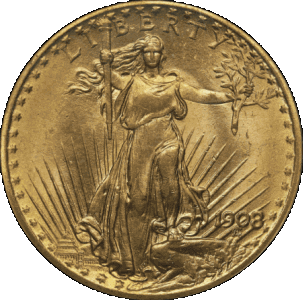
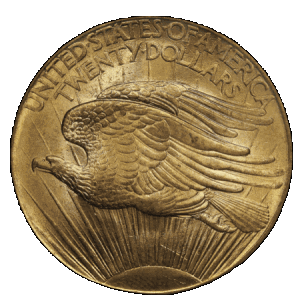
Coin Fact Sheet
| Weight | Face Value | Purity | Diameter |
|---|---|---|---|
| 0.9675 oz | US $ 20 | 90% | 34 mm |
Total Mintage: 70,290,763
Double Eagle Coin Design
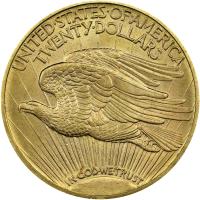
The American president Theodore Roosevelt, who commissioned the coin, wanted a design that emulated the beauty and style of ancient Greek coins. The sculptor Augustus Saint-Gaudens designed the now famous coin that many consider to be the most beautiful of all time. The obverse side shows Lady Liberty facing forward, her left foot resting on a rock, with a torch in her right hand and an olive branch in her left. The sun's rays and the U.S. Capitol building are visible behind and the word “LIBERTY” appears above. The year of mintage, the designer's initials “ASG” and a mintmark for San Francisco (mintmark: S) or Denver (mintmark: D) are inscribed on the lower right. Coins minted at the Philadelphia facility of the United States Mint aren't mintmarked however. The 46 or 48 tiny stars that appear along the periphery of each Saint-Gaudens Gold Double Eagle were meant to represent the number of states in the union at that time. Therefore, 48 stars appear on the coins since 1912.
On the reverse side of each Saint-Gaudens Double Eagle gold coin you will see a flying eagle with the sun and its rays in the background. Above the design are inscribed the coin's denomination “TWENTY DOLLARS” and “UNITED STATES OF AMERICA” whereas the motto “IN GOD WE TRUST” (since 1908) appears underneath.
The edge of the Gold Double Eagles has a special design in that it features 13 raised stars (representing the original 13 states) and the phrase “E PLURIBUS UNUM”.
History of the Saint-Gaudens Double Eagles
The American President Theodore Roosevelt commissioned the issue of the $20 Saint-Gaudens Double Eagle in the early 1900's. The famous design was created by the US Mint sculptor Augustus Saint-Gaudens and production started in 1907. The first 12,367 coins minted in 1907 have the date inscribed in Roman numerals. The motto “IN GOD WE TRUST” was only added to the coin in 1908. Therefore, coins from 1908 exist with and without the motto. During the First World War, production ceased due to a rise in gold bullion prices. Very few specimens of the Gold Double Eagle coins from their final years of mintage (1929-1933) were released into circulation. Most were melted down later due to currency laws passed during the Great Depression, making the surviving specimens especially valuable. Only 3 of the coins minted in 1933 are known to exist today. A few more may have escaped the mint but are illegal to own since they were never officially released into circulation.
Coin Variations
Besides the above mentioned variations (Roman numeral date, motto, number of stars along the border) there are several more noteworthy variations. The 24 coins that were struck first with Saint-Gaudens' original 1907 design are known as "ultra high relief" or "extra high relief", since they were each struck nine times by the coin press. A second lower-relief design in 1907 still required five strokes of the coin press. About 12,000 of these "high relief" coins were minted that year. Mint engraver Charles E. Barber finalized the third and final extremely low relief design and he also changed the engraved year from Roman to Arabic numerals. A further odd variation exists. About 161,000 of the coins produced in 1909 show a light 8 beneath the last 9 in 1909.
Rare Dates
Besides the 1907 high relief coins and the coins minted in 1933, several more issues from certain years and mint facilities are now quite rare. All the coins minted from 1930 to 1932 are now extremely rare since many of them were later melted into bullion.
The 12,367 coins minted in Philadelphia in 1907 with the date in Roman numerals as well as the 1921 Philadelphia issue (528,500 coins minted) have become hard to find.
The coins minted in Denver in 1926 (481,000 coins) and 1927 (180,000 coins) as well as the San Francisco issue from 1920 (558,000 coins) are nowadays also hard to find.
Proof coins are even harder to find if at all possible. Proof coins were exclusively minted in Philadelphia from 1908 to 1915 (as well as 1 proof coin in 1921) and annual proof mintages varied between 50 and 167 coins.
Mintage Numbers
Annual mintage numbers of the Saint-Gaudens Double Eagle coin varied between 22,000 coins (San Francisco 1908) and 4,323,500 coins (Philadelphia 1924). The first 12,367 coins that were minted with the date in Roman numerals in 1907 are the rarest variation of the coin (besides the 1933 coins which are illegal to own anyway).
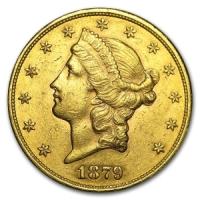
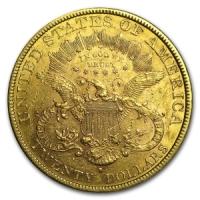
Liberty Gold Double Eagles
The $20 Liberty Gold Double Eagles were the predecessors of the $20 Saint-Gaudens Gold Double Eagles. The US Mint produced the coins from 1849 to 1907. They were struck at the US Mint facilities in Philadelphia, New Orleans, San Francisco, Carson City and Denver. Their composition is 90% gold and 10% copper with each coin containing 0.9675 oz of gold. Almost 104 million Liberty Double Eagles were minted. The coins depict a leftward facing Lady Liberty in profile on the obverse and an eagle that is holding a shield on the reverse. Three main coin subtypes and several additional varieties (for example the coins with a modified Paquet reverse) exist.
The Liberty Gold Double Eagle page gives more information about the coins and allows you to compare current prices.